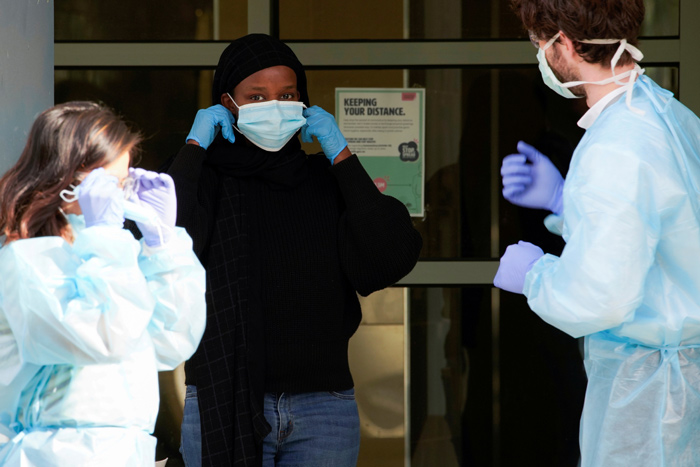世界卫生组织:不排除新冠病毒可以通过空气传播 Airborne transmission of coronavirus in restaurants, gyms and other closed spaces can’t be ruled out, WHO says
中国日报网 2020-07-10 12:46

继全球239名科学家发表公开信呼吁世界卫生组织重视新冠病毒空气传播后,日前世界卫生组织发布新指导意见称,不排除新冠病毒在室内通过空气微粒传播的可能性,但还需要进一步调查来证实。

The World Health Organization published new guidance Thursday, saying it can’t rule out the possibility that the coronavirus can be transmitted through air particles in closed spaces indoors, including in gyms and restaurants.
世界卫生组织周四(7月9日)发布新指导意见称,不能排除新冠病毒在健身馆和餐厅等密闭室内空间通过空气微粒传播的可能性。
The WHO previously acknowledged that the virus may become airborne in certain environments, such as during “medical procedures that generate aerosols.” The new guidance recognizes some research that suggests the virus may be able to spread through particles in the air in “indoor crowded spaces.” It cited “choir practice, in restaurants or in fitness classes” as possible areas of airborne transmission.
世界卫生组织此前承认,新冠病毒可能会在特定环境中通过空气传播,比如在“能产生气溶胶的医疗过程中”。新指导意见认可了一些研究发现,即病毒可能会在“室内拥挤空间”中通过空气中的微粒传播。意见援引了“唱诗班、餐厅或健身课”作为可能出现空气传播的地方。
aerosol [ˈerəsɑːl]: n.气溶胶
"In these events, short-range aerosol transmission, particularly in specific indoor locations, such as crowded and inadequately ventilated spaces over a prolonged period of time with infected persons cannot be ruled out,” the United Nations health agency’s new guidance said.
世界卫生组织的这份新指导意见称:“在这些情况下,不能排除感染者长时间待过的特定室内场所,比如拥挤且通风不良的空间”,会出现短程的气溶胶传播。”
The WHO said in its guidance that while early evidence suggests the possibility of airborne transmission in such environments, spread by droplets and surfaces could also explain transmission in those cases.
世界卫生组织在指导意见中表示,尽管早期证据显示这些环境中有可能出现空气传播,但飞沫和表面传播也可以解释这些情况。
"However, the detailed investigations of these clusters suggest that droplet and fomite transmission could also explain human-to-human transmission within these clusters,” the guidance said.
指导意见中写道:“然而,对这些聚集性病例的详尽调查显示,飞沫和污染物传播也可以解释这些聚集性病例的人际传播。”
fomite ['fo,maɪt]: n. 污染物
The WHO added that more research is needed to further investigate preliminary findings. The agency said the main mode of transmission is still believed to be through respiratory droplets.
世界卫生组织补充道,还需要更多研究来进一步调查这些初步发现,目前仍然认为主要传播途径是通过呼吸道产生的飞沫。
Airborne transmission of the coronavirus could occur if virus-carrying droplets “generate microscopic aerosols” by evaporating, the WHO said, or if “normal breathing and talking results in exhaled aerosols.” In theory, the WHO said someone could inhale the aerosols and become infected. But it remains unknown, the WHO said, if such aerosols would actually carry enough viable virus to cause infection.
世界卫生组织称,如果携带病毒的飞沫通过蒸发“产生气溶胶微粒”,新冠病毒就有可能通过空气传播。理论上,某人可以吸入气溶胶从而被感染,但是这些气溶胶实际上是否能够携带足以造成感染的活性病毒仍然未知。
The WHO said it is further researching the role of different modes of spread, including by air, as well as how much virus is required to potentially infect someone and what kinds of environments create greater risk for spread.
世界卫生组织表示,正在进一步调查不同传播途径的作用,包括通过空气传播,以及需要多少病毒才可能感染一个人,还有什么样的环境会加大传播风险。
If airborne transmission proves to be a major factor in the spread of the virus, it could have wide-ranging policy consequences. Masks may prove to be even more important in reducing infections, especially in indoor environments and even in areas where physical distancing is possible. And more specialized masks designed to block microscopic particles may become more important. Specially outfitted ventilation units designed to kill the virus in circulating air could prove critical in preventing spread in indoor, congregate settings.
如果空气传播被证实是病毒传播的一个主要因素,可能会对政策产生广泛影响。或将证明口罩对于减少感染更加重要,尤其是在室内环境甚至在可以保持距离的地方;设计出更专业化的口罩来阻隔微粒会变得更加重要;证明专门配备的能杀死流通空气中病毒的通风设备对于防止室内和人群聚集地的病毒传播十分关键。
The new guidance comes after 239 scientists from 32 different countries published an open letter earlier this week calling for the WHO and other health authorities to update their information on the coronavirus.
在新指导意见发布前,本周早些时候来自32个国家的239名科学家发表了一封公开信,呼吁世界卫生组织和其他卫生部门更新关于新冠病毒的信息。
In an article entitled “It is Time to Address Airborne Transmission of COVID-19,” the group of scientists contend that the WHO needs to give more weight to the role of the airborne spread of Covid-19.
在一篇题为“是时候应对新冠病毒的空气传播了”的文章中,这个科学家团队指出,世界卫生组织需要更重视新冠病毒通过空气传播的作用。
英文来源:CNBC
翻译&编辑:丹妮

















 英语点津微信
英语点津微信 双语小程序
双语小程序